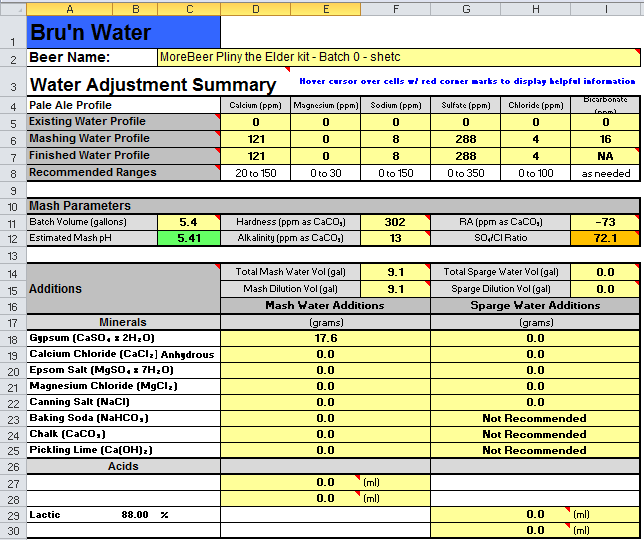- Joined
- Jul 28, 2013
- Messages
- 3,109
- Reaction score
- 5,576
Hi Guys,
I'm trying my first serious attempt at using the Bru'n Water calculator. I will be brewing the MoreBeer Pliny the Elder DIPA all-grain kit, using a full volume BIAB with all RO water. The image below shows the Adjustment Summary from the calculator. Since this will be a full volume BIAB, I have included all the required volume of water in the Total Mash Water Vol, and zero Total Sparge Water Vol.
You can see an image of the Adjustment Summary below. Based on my DIPA research, "Boosting the sulfate level into the 200 to 300 ppm is a necessary thing to assist in drying the beer's finish and allowing the hops and bitter to make it out from under all that malt" (mabrungard, Help formulating water profile for DIPA). So I adjusted the water profile with just gypsum, which brought the sulfate to 288 ppm and lowered the pH to 5.41. It seems simple enough -- did I use the calculator correctly?
Thanks,
Steve

I'm trying my first serious attempt at using the Bru'n Water calculator. I will be brewing the MoreBeer Pliny the Elder DIPA all-grain kit, using a full volume BIAB with all RO water. The image below shows the Adjustment Summary from the calculator. Since this will be a full volume BIAB, I have included all the required volume of water in the Total Mash Water Vol, and zero Total Sparge Water Vol.
You can see an image of the Adjustment Summary below. Based on my DIPA research, "Boosting the sulfate level into the 200 to 300 ppm is a necessary thing to assist in drying the beer's finish and allowing the hops and bitter to make it out from under all that malt" (mabrungard, Help formulating water profile for DIPA). So I adjusted the water profile with just gypsum, which brought the sulfate to 288 ppm and lowered the pH to 5.41. It seems simple enough -- did I use the calculator correctly?
Thanks,
Steve



